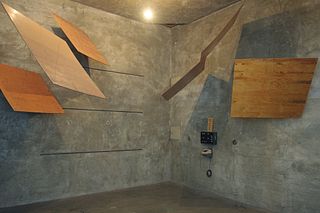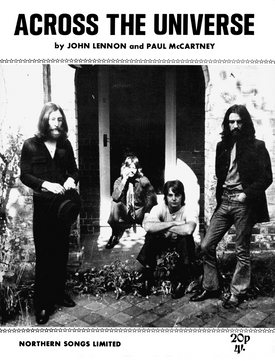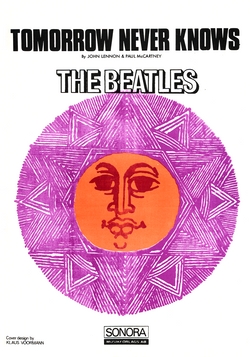
Revolver is the seventh studio album by the English rock band the Beatles. It was released on 5 August 1966, accompanied by the double A-side single "Eleanor Rigby" / "Yellow Submarine". The album was the Beatles' final recording project before their retirement as live performers and marked the group's most overt use of studio technology to date, building on the advances of their late 1965 release Rubber Soul. It has since become regarded as one of the greatest and most innovative albums in popular music, with recognition centred on its range of musical styles, diverse sounds, and lyrical content.

The Beatles, also known as the White Album, is the ninth studio album and only double album by the English rock band the Beatles, released on 22 November 1968. Its plain white sleeve has no graphics or text other than the band's name embossed, which was intended as a direct contrast to the vivid cover artwork of the band's previous LP Sgt. Pepper's Lonely Hearts Club Band. The Beatles is recognised for its fragmentary style and diverse range of genres, including folk, British blues, ska, music hall and the avant-garde. It has since been viewed by some critics as a postmodern work, as well as among the greatest albums of all time.

Geoffrey E. Emerick was an English sound engineer who worked with the Beatles on their albums Revolver (1966), Sgt. Pepper's Lonely Hearts Club Band (1967) and Abbey Road (1969). Beatles producer George Martin credited him with bringing "a new kind of mind to the recordings, always suggesting sonic ideas, different kinds of reverb, what we could do with the voices".

An echo chamber is a hollow enclosure used to produce reverberation, usually for recording purposes. For example, the producers of a television or radio program might wish to produce the aural illusion that a conversation is taking place in a large room or a cave; these effects can be accomplished by playing the recording of the conversation inside an echo chamber, with an accompanying microphone to catch the reverberation. Nowadays effects units are more widely used to create such effects, but echo chambers are still used today, such as the famous echo chambers at Capitol Studios.
Automatic double-tracking or artificial double-tracking (ADT) is an analogue recording technique designed to enhance the sound of voices or instruments during the mixing process. It uses tape delay to create a delayed copy of an audio signal which is then combined with the original. The effect is intended to simulate the sound of the natural doubling of voices or instruments achieved by double tracking. The technique was originally developed in 1966 by engineers at Abbey Road Studios in London at the request of The Beatles.

"Love Me Do" is the debut single by the English rock band the Beatles, backed by "P.S. I Love You". When the single was originally released in the United Kingdom on 5 October 1962, it peaked at number 17. In 1982 it was re-promoted and reached number four. It was released in the United States in 1964, where it became a number one hit.

"Paperback Writer" is a song by the English rock band the Beatles. Written primarily by Paul McCartney and credited to the Lennon–McCartney partnership, the song was released as the A-side of their eleventh single in May 1966. It topped singles charts in Britain, the United States, Ireland, West Germany, Australia, New Zealand and Norway. On the US Billboard Hot 100, the song was at number 1 for two non-consecutive weeks, being interrupted by Frank Sinatra's "Strangers in the Night".

"I'm Only Sleeping" is a song by the English rock band the Beatles from their 1966 studio album Revolver. In the United States and Canada, it was one of the three tracks that Capitol Records cut from the album and instead included on Yesterday and Today, released two months before Revolver. Credited as a Lennon–McCartney song, it was written primarily by John Lennon. The track includes a backwards lead guitar part, played by George Harrison, marking the first time that such a technique had been used on a pop recording.

"Rain" is a song by the English rock band the Beatles that was released on 30 May 1966 as the B-side of their "Paperback Writer" single. Both songs were recorded during the sessions for Revolver, although neither appear on that album. "Rain" was written by John Lennon and credited to the Lennon–McCartney partnership. He described its meaning as "about people moaning about the weather all the time".
"Revolution 9" is a sound collage that appeared on the Beatles' 1968 eponymous release. The composition, credited to Lennon–McCartney, was created primarily by John Lennon with assistance from George Harrison and Yoko Ono. Lennon said he was trying to paint a picture of a revolution using sound. The composition was influenced by the avant-garde style of Ono as well as the musique concrète works of composers such as Edgard Varèse and Karlheinz Stockhausen.

"Maxwell's Silver Hammer" is a song by the English rock band the Beatles from their 1969 album Abbey Road. It was written by Paul McCartney, although credited to Lennon–McCartney. "Maxwell's Silver Hammer" is a pop song with dark, eccentric lyrics about a student named Maxwell Edison who commits murders with a hammer. The lyrics are disguised by the upbeat, catchy, and "childlike" sound of the song. The recording sessions for the track were an acrimonious time for the Beatles, as McCartney pressured his bandmates to work at length on the song. John Lennon, George Harrison and Ringo Starr were vocal in their dislike of the song. Author Ian MacDonald began his description of the song by saying, "If any single recording shows why The Beatles broke up, it is 'Maxwell's Silver Hammer'."

"Across the Universe" is a song by the English rock band the Beatles. It was written by John Lennon and credited to Lennon–McCartney. The song first appeared on the 1969 various artists' charity compilation album No One's Gonna Change Our World and later, in a different form, on their 1970 album Let It Be, the group's final released album.

"Tomorrow Never Knows" is a song by the English rock band the Beatles, written primarily by John Lennon and credited to Lennon–McCartney. It was released in August 1966 as the final track on their album Revolver, although it was the first song recorded for the LP. The song marked a radical departure for the Beatles, as the band fully embraced the potential of the recording studio without consideration for reproducing the results in concert.

"Carnival of Light" is an unreleased avant-garde recording by the English rock band the Beatles that was commissioned for The Million Volt Light and Sound Rave, an event held at the Roundhouse in London on 28 January and 4 February 1967. Recorded during a session for "Penny Lane", "Carnival of Light" is nearly 14 minutes long and contains distorted, echo-laden sounds of percussion, keyboards, guitar and vocals. All four Beatles were present at the session, although Paul McCartney and John Lennon are the only voices heard on the track. Portions of the recording were later possibly featured on the similar "Revolution 9" (1968).

"What You're Doing" is a song by the English rock band the Beatles from their album Beatles for Sale, released in December 1964. It was written by Paul McCartney, although credited to Lennon–McCartney. The song was one of eight original compositions on Beatles for Sale. In North America, where Capitol Records typically altered the content of the band's albums, "What You're Doing" instead appeared on the 1965 US release Beatles VI.

"Baby, You're a Rich Man" is a song by the English rock band the Beatles that was released as the B-side of their "All You Need Is Love" single in July 1967. It originated from an unfinished song by John Lennon, titled "One of the Beautiful People", to which Paul McCartney added a chorus. It is one of the best-known pop songs to feature a clavioline, a monophonic keyboard instrument that was a forerunner to the synthesizer. Lennon played the clavioline on its oboe setting, creating a sound that suggests an Indian shehnai. The song was recorded and mixed at Olympic Sound Studios in London, making it the first of the Beatles' EMI recordings to be entirely created outside EMI Studios.
"Not Guilty" is a song by English rock musician George Harrison from his 1979 album George Harrison. He wrote the song in 1968 following the Beatles' Transcendental Meditation course in India with Maharishi Mahesh Yogi, an activity that he had led the group in undertaking. The lyrics refer to Harrison's relationship with his bandmates John Lennon and Paul McCartney in the aftermath to their falling out with the Maharishi and as the Beatles launched their multimedia company Apple Corps. The band spent several days recording the song amid the tensions that characterised the sessions for their 1968 double album The Beatles. The track was completed in August 1968 but not included on the release.

The studio practices of the Beatles evolved during the 1960s, and in some cases, influenced the way popular music was recorded. Some of the effects they employed were sampling, artificial double tracking (ADT) and the elaborate use of multitrack recording machines. They also used classical instruments on their recordings and guitar feedback. The group's attitude toward the recording process was summed up by Paul McCartney: "We would say, 'Try it. Just try it for us. If it sounds crappy, OK, we'll lose it. But it might just sound good.' We were always pushing ahead: Louder, further, longer, more, different."
The recordings made by the Beatles, a rock group from Liverpool, England, from their inception as the Quarrymen in 1957 to their break-up in 1970 and the reunion of their surviving members in the mid-1990s, have huge cultural and historical value. The studio session tapes are kept at Abbey Road Studios, formerly known as "EMI Recording Studios," where the Beatles recorded most of their music. While most have never been officially released, their outtakes and demos are seen by fans as collectables, and some of the recordings have appeared on countless bootlegs. Until 2013, the only outtakes and demos to be officially released were on The Beatles Anthology series and its tie-in singles, and bits of some previously unreleased studio recordings were used in The Beatles: Rock Band video game as ambient noise and to give songs studio-sounding beginnings and endings. In 2013, Apple Records released the album The Beatles Bootleg Recordings 1963, which includes previously unreleased outtakes and demos from 1963, to stop the recordings from falling into the public domain.














